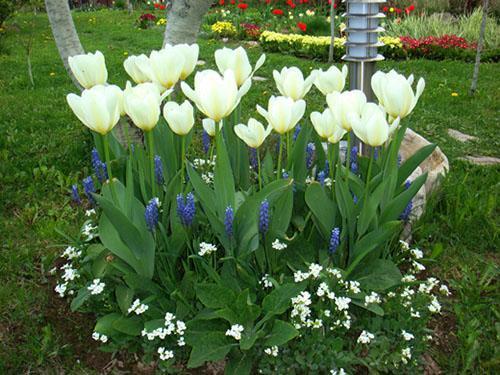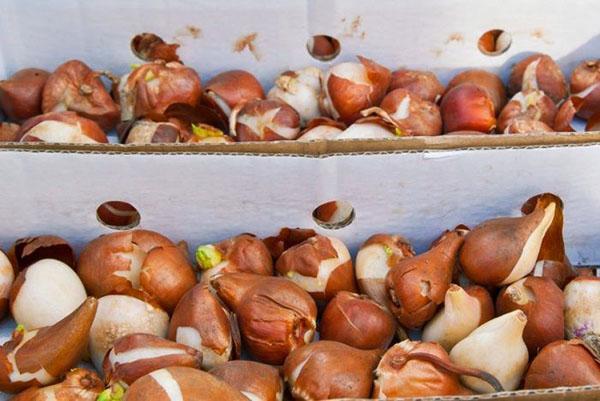All about digging tulip bulbs and how to store them
 To enjoy beautiful blooms every year, you need to know when to dig tulips... They will be the queens of the flower garden in the spring, if the owners do not forget about the simple rules of agricultural technology. Is digging up the bulbs a must, or can you do without it?
To enjoy beautiful blooms every year, you need to know when to dig tulips... They will be the queens of the flower garden in the spring, if the owners do not forget about the simple rules of agricultural technology. Is digging up the bulbs a must, or can you do without it?
Why do they dig up tulips?

- In this way, the most convenient conditions are provided so that the buds of flowering are laid. When the bulbs are left in the ground, they can suffer from excess moisture, infections, and lack of heat. As a result, the planting material may die. Therefore, it is worth knowing when to dig up the tulip bulbs to preserve them.
- Digging allows you to eliminate weak and diseased planting material.

- If the bulbs are left in the soil, they are crushed, which affects the further flowering. When a person digs them up, he can select large and high-quality planting material. It is recommended to throw out small children, as they will spoil the flower garden.
- If you do not dig it up, new small bulbs will begin to sink into the soil. As a result, it will be difficult to find them in the future, and the area will become clogged.
Every grower needs to know when to dig up tulips. This will help maintain good soil condition, high-quality flowering.
Tulips will not be able to develop normally in the soil without digging them out for many years. As a result, the flowers will be small, they may even die.
When to dig up the bulbs?
 So when to dig up tulips after flowering? This procedure is often carried out in late June or early July. The main sign that you need to dig up the bulbs is yellowed leaves.
So when to dig up tulips after flowering? This procedure is often carried out in late June or early July. The main sign that you need to dig up the bulbs is yellowed leaves.  When they have turned yellow almost completely, then it is worth starting the procedure. During such a period, the bulbs will already get stronger, children are well attached to them, which have not yet fallen off.
When they have turned yellow almost completely, then it is worth starting the procedure. During such a period, the bulbs will already get stronger, children are well attached to them, which have not yet fallen off.
There is no need to wait for the foliage to die off completely, because then it is difficult to find bulbs in the ground. In addition, prolonged exposure to soil increases the risk of infection, leading to the separation of children, which may be lost in the ground.

 You still need to know some of the nuances as to when to dig up tulips. This should be done in dry weather so that the soil is crumbly. The procedure is performed carefully, the old scales are removed, the bulbs are washed in a solution of potassium permanganate, and they are arranged according to varieties. Bad planting material is thrown away.
You still need to know some of the nuances as to when to dig up tulips. This should be done in dry weather so that the soil is crumbly. The procedure is performed carefully, the old scales are removed, the bulbs are washed in a solution of potassium permanganate, and they are arranged according to varieties. Bad planting material is thrown away.
How are bulbs stored?
 Florists need to know not only when to dig up tulips, but also how to store the bulbs. Proper storage is essential. The planting material is dried in a dry and warm place that is well ventilated. Suitable for this:
Florists need to know not only when to dig up tulips, but also how to store the bulbs. Proper storage is essential. The planting material is dried in a dry and warm place that is well ventilated. Suitable for this:
- canopy;
- attic;
- barn;
- nylon nets designed for Luke.
 It is recommended to remove diseased bulbs in a timely manner, protect from direct sunlight.A few days will pass, the scales will dry out, which must be removed. The bulbs are cleaned of soil residues and dry roots, the children are separated. After that, the planting material is moved. Large, healthy bulbs are suitable for planting.
It is recommended to remove diseased bulbs in a timely manner, protect from direct sunlight.A few days will pass, the scales will dry out, which must be removed. The bulbs are cleaned of soil residues and dry roots, the children are separated. After that, the planting material is moved. Large, healthy bulbs are suitable for planting.
 People often wonder if tulips need to be dug up every year. This is not a mandatory procedure, but experienced florists advise doing this annually. Even if a person does not dig up the bulbs, he will definitely need to do this for 2-3 years.
People often wonder if tulips need to be dug up every year. This is not a mandatory procedure, but experienced florists advise doing this annually. Even if a person does not dig up the bulbs, he will definitely need to do this for 2-3 years.